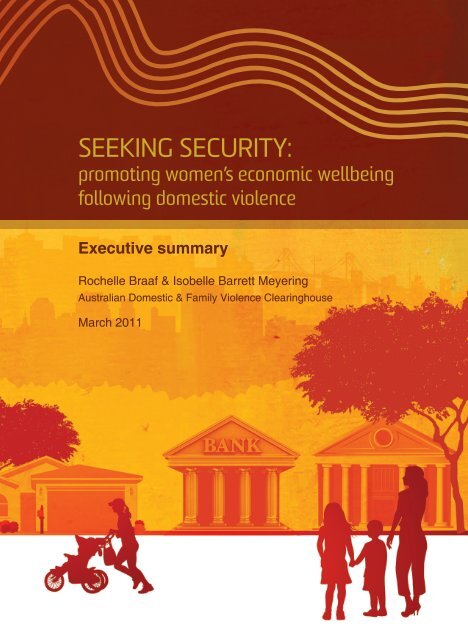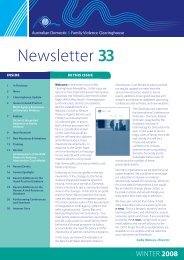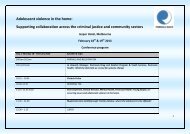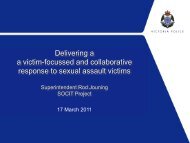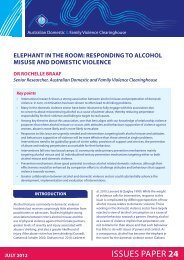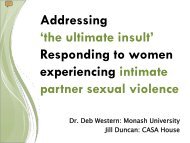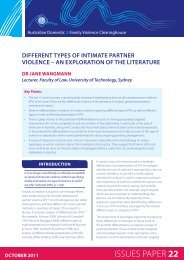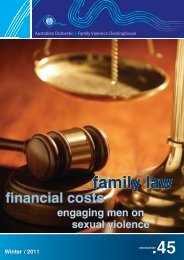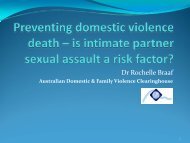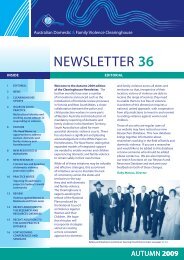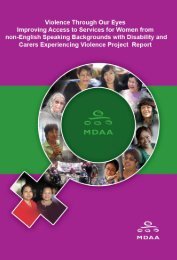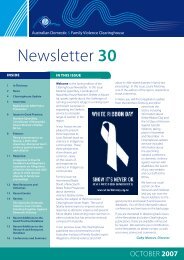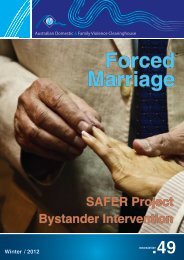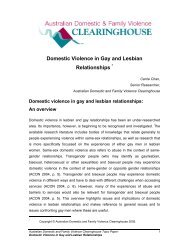Seeking Security: - Australian Domestic and Family Violence ...
Seeking Security: - Australian Domestic and Family Violence ...
Seeking Security: - Australian Domestic and Family Violence ...
You also want an ePaper? Increase the reach of your titles
YUMPU automatically turns print PDFs into web optimized ePapers that Google loves.
<strong>Seeking</strong> security:<br />
promoting women’s economic wellbeing<br />
following domestic violence<br />
Executive summary<br />
Rochelle Braaf & Isobelle Barrett Meyering<br />
<strong>Australian</strong> <strong>Domestic</strong> & <strong>Family</strong> <strong>Violence</strong> Clearinghouse<br />
March 2011
Produced by the <strong>Australian</strong> <strong>Domestic</strong> <strong>and</strong> <strong>Family</strong> <strong>Violence</strong> Clearinghouse<br />
for the Department of Families, Housing, Community Services <strong>and</strong> Indigenous Affairs<br />
Sydney<br />
© March 2011<br />
The views expressed in this report do not necessarily represent the views of the <strong>Australian</strong><br />
Government. The <strong>Australian</strong> <strong>Domestic</strong> <strong>and</strong> <strong>Family</strong> <strong>Violence</strong> Clearinghouse is funded by<br />
the <strong>Australian</strong> Government Department of Families, Housing, Community Services <strong>and</strong><br />
Indigenous Affairs. The Clearinghouse is linked to the Centre for Gender-Related <strong>Violence</strong><br />
Studies, based in the University of New South Wales, School of Social Sciences <strong>and</strong><br />
International Studies.<br />
Authors<br />
Rochelle Braaf & Isobelle Barrett Meyering<br />
with research assistance by Emily Hamilton, Sarah MacGregor, Sarit Huppert <strong>and</strong> Rosa<br />
Campbell, <strong>and</strong> management support by Gaby Marcus <strong>and</strong> Jan Breckenridge<br />
Editing services provided by Jen Hamer<br />
<strong>Australian</strong> <strong>Domestic</strong> & <strong>Family</strong> <strong>Violence</strong> Clearinghouse<br />
The University of New South Wales<br />
UNSW Sydney NSW 2052 Australia<br />
p: +61 2 9385 2990 f: +61 2 9385 2993 freecall: 1800 753 382<br />
e: clearinghouse@unsw.edu.au w: www.adfvc.unsw.edu.au
Acknowledgements<br />
This research was made possible through funding by the Commonwealth Department of Families,<br />
Housing, Community Services <strong>and</strong> Indigenous Affairs (FaHCSIA). We commend the department for<br />
supporting investigation of the financial dimension of domestic violence for women.<br />
The study was also made possible through the generous support of the eight services who<br />
participated in the research. From the outset, the managers <strong>and</strong> workers of these services<br />
expressed great interest in the subject. They willingly provided space for meetings, precious staff<br />
time to participate in focus groups <strong>and</strong> interviews, <strong>and</strong> engaged in many additional conversations<br />
regarding follow up issues. Their experience <strong>and</strong> expertise significantly informed the research, <strong>and</strong><br />
their existing efforts to promote women’s financial security, we hope, will inspire further initiatives in<br />
this area.<br />
Our greatest debt of gratitude goes to the clients of these services, women who freely gave<br />
their time to share with us their experiences <strong>and</strong> views. Despite the often painful nature of these<br />
sessions, women were keen to participate in order to bring about change – for themselves <strong>and</strong> for<br />
other women. We were deeply sorrowed by the devastation to women’s lives caused by abusive<br />
partners <strong>and</strong> failed systems. We were also greatly moved by the countless demonstrations of<br />
resilience <strong>and</strong> courage women showed in overcoming the hurdles laid in their path, <strong>and</strong> the,<br />
oftentimes, amazing forward strides they had made in their lives.<br />
1<br />
We dedicate this report to these women <strong>and</strong> call on policy makers, agency workers, advocates <strong>and</strong><br />
practitioners to enact the recommendations of this study, in order to promote the financial security,<br />
independence <strong>and</strong> freedom that women deserve.<br />
www.adfvc.unsw.edu.au
2<strong>Seeking</strong> <strong>Security</strong>: Promoting Women’s Economic Wellbeing Following <strong>Domestic</strong> <strong>Violence</strong><br />
Contents<br />
Introduction............................................................................................................................... 3<br />
Research aims.......................................................................................................................... 3<br />
Research methods <strong>and</strong> participants......................................................................................... 4<br />
Findings..................................................................................................................................... 4<br />
Conclusions............................................................................................................................. 13<br />
List of recommendations......................................................................................................... 13<br />
References.............................................................................................................................. 17
Introduction<br />
<strong>Domestic</strong> violence is a pervasive social issue in this country, with an estimated 15-17% of <strong>Australian</strong><br />
women affected over the course of their lifetime (<strong>Australian</strong> Bureau of Statistics 2006, p. 5). It is also<br />
expensive, costing the <strong>Australian</strong> economy in the order of $13.6 billion in 2008-09 alone (National Council<br />
to Reduce <strong>Violence</strong> against Women <strong>and</strong> their Children 2009a, p. 34). Beneath these figures lie numerous<br />
individual experiences of abuse <strong>and</strong> women’s hard-fought struggles to be free from the immediate <strong>and</strong><br />
ongoing effects of violence that permeate their lives.<br />
This research has been specifically concerned to examine the impact of domestic violence on women’s<br />
economic wellbeing <strong>and</strong> the intersection of this with their recovery overall. To do this, the research<br />
explored the ways in which domestic violence creates complex economic issues for women (<strong>and</strong> their<br />
children), <strong>and</strong> how this disrupts their lives over the short <strong>and</strong> long term. It has been equally concerned<br />
with investigating personal strategies <strong>and</strong> service initiatives that support those who have left violence to<br />
break free from financial uncertainty. The study was conducted in 2009 by the <strong>Australian</strong> <strong>Domestic</strong> <strong>and</strong><br />
<strong>Family</strong> <strong>Violence</strong> Clearinghouse, which is a project of the Centre for Gender-Related <strong>Violence</strong> Studies at<br />
the University of New South Wales.<br />
The findings of the research are consistent with national <strong>and</strong> international research studies that point to<br />
numerous ways in which domestic violence impacts on women’s financial outcomes. This study goes<br />
further to highlight that for women experiencing domestic violence, financial security goes to the heart of<br />
not only their freedom from abuse, but also their recovery <strong>and</strong> capacity to (re)gain control over their lives,<br />
now <strong>and</strong> in the future.<br />
3<br />
Importantly, the study has a direct bearing on current debates in Australia concerning social inclusion<br />
(<strong>and</strong> by extension, social justice) <strong>and</strong>, specifically, the Federal Government’s social inclusion agenda. 1<br />
In February 2008, then Deputy Prime Minister Julia Gillard defined social inclusion as the capacity for<br />
people to find employment; access services; maintain social networks through family, friends, work,<br />
personal interests <strong>and</strong> their local community; deal with personal crises such as ill health, bereavement or<br />
the loss of a job; <strong>and</strong> have their voice heard (2008). This research demonstrates how significantly men’s<br />
violence towards their female partners contributes to women’s social exclusion. This is apparent through<br />
its direct negative impact on victims’ material wealth <strong>and</strong> health outcomes. <strong>Domestic</strong> violence is also<br />
a disempowering force, undermining the confidence of those affected <strong>and</strong> often inviting discrimination<br />
against them. Efforts to prevent <strong>and</strong> mitigate the economic effects of domestic violence on victims are,<br />
thereby, central to promoting women’s social inclusion.<br />
Research Aims<br />
Considerable research has already been undertaken to investigate the impact of domestic violence on<br />
women’s lives. Studies have focussed on specific issues such as the impact on: employment (Franzway,<br />
Zufferey & Chung 2007; Lloyd 1997, p. 73; Moe & Myrtle 2004); use of welfare (Riger & Staggs 2004b);<br />
property <strong>and</strong> financial settlements (Sheehan & Smyth 2000); homelessness (<strong>Australian</strong> Institute of Health<br />
<strong>and</strong> Welfare 2008b; Correia & Melbin 2005); <strong>and</strong> on the financial abuse of women (Branigan 2004;<br />
Evans 2007). However, there has been limited attention, particularly in Australia, to drawing these issues<br />
together to generate a more comprehensive picture of the impact upon a victim’s ongoing financial status<br />
or to investigate pathways to safety through financial security. This study has, therefore, sought to fill<br />
those gaps <strong>and</strong> identify points for intervention.<br />
1 In 2008, the Federal Government set a national agenda to promote social inclusion in Australia. In addition to launching a web site <strong>and</strong><br />
establishing a Social Inclusion Unit in Government, it released its Principles for Social Inclusion to guide individuals, business <strong>and</strong> community<br />
organisations, <strong>and</strong> government to promote social inclusion in their activities. See the Federal Government’s Social Inclusion web site. Viewed<br />
4 June 2010 .<br />
www.adfvc.unsw.edu.au
4<strong>Seeking</strong> <strong>Security</strong>: Promoting Women’s Economic Wellbeing Following <strong>Domestic</strong> <strong>Violence</strong><br />
The research specifically aimed to:<br />
1. investigate ways in which domestic violence undermines women’s financial circumstances<br />
<strong>and</strong>, in turn, how poverty affects their efforts to gain safety<br />
2. investigate strategies that support positive economic outcomes for women<br />
3. develop <strong>and</strong> promote the implementation of these strategies, to support women’s financial<br />
security <strong>and</strong> pathways to safety.<br />
Research methods <strong>and</strong> participants<br />
A review of the literature undertaken for the study identified nine key areas of life where domestic violence<br />
directly affects women’s financial security: debts, bills <strong>and</strong> banking; accommodation; legal issues; health;<br />
transport; migration; employment; social security; <strong>and</strong> child support. Questions related to these areas<br />
were used to initiate discussion with participants, with the interviews remaining open-ended <strong>and</strong> reflexive<br />
to allow for other issues to emerge.<br />
The researchers worked with eight diverse services, who recruited female clients <strong>and</strong> workers to<br />
participate in the study. There were one hundred <strong>and</strong> seven (107) participants in total:<br />
• thirty-two individual interviews with women affected by domestic violence<br />
• seven focus groups attended by 25 women affected by domestic violence<br />
• eight focus groups attended by 49 workers<br />
• one individual interview with a worker. 2<br />
The interviews <strong>and</strong> focus groups explored barriers to participant’s financial security pre <strong>and</strong> post violent<br />
relationships <strong>and</strong> the strategies <strong>and</strong> responses that assisted them to be more financially secure. The<br />
research specifically looked for behaviours <strong>and</strong> actions of the abusive partners that contributed to<br />
the women’s financial insecurity <strong>and</strong> what role the services, agencies, utilities <strong>and</strong> other organisations<br />
played in assisting or hindering women’s efforts to become financially secure. Workers were also asked<br />
to complete a survey concerning their perception of the usefulness of different strategies to assist their<br />
clients’ financial security.<br />
Interviews <strong>and</strong> focus groups were recorded <strong>and</strong> thematic analysis was applied to identify major trends<br />
<strong>and</strong> patterns. Researchers were also interested in unique issues arising in individual cases that provided<br />
a deeper picture of the participant’s experiences.<br />
In March 2010, a worker’s forum was held to discuss the study findings <strong>and</strong> to identify <strong>and</strong> share<br />
strategies <strong>and</strong> responses that services could take, to better support women’s financial circumstances.<br />
Discussion within this forum contributed to the formulation of the research recommendations.<br />
Findings<br />
The research identified:<br />
• seven key messages that underpin a sound underst<strong>and</strong>ing of women’s economic needs<br />
• eleven critical areas of life where women’s financial security is significantly affected <strong>and</strong><br />
where intervention can have optimum effect.<br />
2 This worker was unable to participate in a focus group with other staff.
Key messages from the research<br />
First Key Message<br />
The decision to stay or leave an abusive relationship is, for many women affected by financial factors.<br />
Finances exert an influence in two directions:<br />
1. impetus to leave: suffering financial abuse, control or manipulation is a trigger for some<br />
women to leave<br />
That was a lot of the reason why I left, because he preferred to pay for alcohol than buy nappies for our<br />
baby. [Service 3 Client focus group]<br />
The main thing was the finances. My partner used financial manipulation to pressure me. I didn’t<br />
realise it was going on because I didn’t think it could happen to me... [Service 3 Client 2]<br />
2. obstacle to leaving: feeling imprisoned by financial need: not having financial independence<br />
or being able to imagine coping financially, keeps many victims trapped in the abusive<br />
relationship.<br />
It was a big part of it… I thought, ‘How do I have all my needs – groceries, medications – met I<br />
thought, ‘What am I going to do’ It took two to three years for me to finally say, ‘What’s worse: doing<br />
without or doing this’ [Service 4 Client 3]<br />
5<br />
Second Key Message<br />
Financial assistance is required in different forms at different stages of a violent relationship <strong>and</strong> should<br />
be tailored to the specific needs of each stage. This includes before leaving, immediately after leaving,<br />
<strong>and</strong> to support longer term recovery.<br />
I think it’s from when you think that ‘I need to leave but how do I leave I haven’t got enough money’ to<br />
when you have left <strong>and</strong> then all the bills that pile up afterwards which can be just as hard. [Service 7<br />
Client focus group]<br />
Third Key Message<br />
The experience of domestic violence significantly contributes to poverty, financial risk <strong>and</strong> financial<br />
insecurity for women, sometimes long after they have left the relationship.<br />
I actually feel financially ruined… And that money was taken away from me because of the law of<br />
the family court <strong>and</strong> the way that they manipulated or he manipulated the situation, making me now<br />
a victim of financial hardship. Whereas, ok I’ve got a job but I’m the working poor <strong>and</strong> no matter how<br />
much I will get, I will always be back... It’s like I’m back at day one, starting like a new graduate working<br />
with now three kids to take care of. [Service 7 Client focus group 2]<br />
I’ve got no money. I don’t know where the money for the next meal is coming from. I’ve got nothing.<br />
[Service 3 Client 2]<br />
Fourth Key Message<br />
There is a significant lack of perpetrator accountability for actions that undermine women’s financial<br />
security.<br />
I ended up going insolvent... because my partner left me in debt because all the bills were in my name of<br />
course. I had a [loan] contract... now that’s a black mark against my name <strong>and</strong> I can’t get loans <strong>and</strong> I can’t get<br />
all that sort of stuff… I’m really struggling... He gets away with it scot-free. [Service 5 Client focus group]<br />
www.adfvc.unsw.edu.au
6<strong>Seeking</strong> <strong>Security</strong>: Promoting Women’s Economic Wellbeing Following <strong>Domestic</strong> <strong>Violence</strong><br />
Fifth Key Message<br />
Financial insecurity hinders women’s recovery from the trauma of the violence in two important ways:<br />
1. women cannot access the support they need for themselves or their children<br />
I had a fall last year during a panic attack <strong>and</strong> broke my ankle in two places. I probably need an<br />
operation but won’t know until I’ve had physio treatment, which I can’t afford. I have an ankle brace on it<br />
until I can afford the physio. I also suffer from anxiety which gives me neck <strong>and</strong> shoulder pain, but I can’t<br />
afford the treatment. I take a lot of pain killers. [Service 7 Client focus group 2]<br />
2. ongoing financial implications of domestic violence are an extension of the abuse <strong>and</strong> can be<br />
prolonged by perpetrators’ actions.<br />
I think that I’ve lived with domestic violence for thirteen years <strong>and</strong> getting out of it I thought that I will be<br />
free of it but my barrier to freedom is the money. [Service 7 Client focus group 2]<br />
Sixth Key Message<br />
Women’s access to services that alleviate poverty is hindered by lack of knowledge <strong>and</strong> an inconsistent<br />
<strong>and</strong> complex service system. Workers responses in many cases may not assist in guiding victims<br />
through this maze, but can cause further trauma <strong>and</strong> disempowerment.<br />
I think that’s what it is, if people are aware that there’s help there, because I just had no idea. I mean, you hear<br />
of crisis care <strong>and</strong> things like that but you don’t actually know. I have actually rung counsellors, I have been to<br />
a counsellor about the situation but never been told about it [domestic violence]. [Service 2 Client 1]<br />
Seventh Key Message<br />
Advocacy to navigate legal <strong>and</strong> other service systems <strong>and</strong> claim entitlements is critical to assist women<br />
to achieve financial security. Advocacy helps individuals in all areas <strong>and</strong> maximises the efficiency of all<br />
services, but is not sufficiently resourced.<br />
To be able to have one person <strong>and</strong> explain the possibility of where I will go financially, <strong>and</strong> how court’s going<br />
to work, <strong>and</strong> whether I will be able to look for employment or not, <strong>and</strong> whether I’m going to have to see a<br />
private lawyer or not, <strong>and</strong> how all that’s going to work, would be a great help. [Service 2 Client 5]<br />
Eleven critical areas for intervention<br />
Where specifically does domestic violence intersect with financial security <strong>and</strong> what are its effects The<br />
following eleven areas of concern emerge clearly from this research:<br />
1. Deciding to leave<br />
2. Debts, bills <strong>and</strong> banking<br />
3. Accommodation<br />
4. Legal issues<br />
5. Health<br />
6. Transport<br />
7. Migration<br />
8. Employment<br />
9. Social security<br />
10. Child support<br />
11. Service capacity
Deciding to Leave<br />
Financial circumstances played a significant role in women’s decisions to end an abusive relationship.<br />
Two patterns emerged: some women indicated that their lack of financial security within the relationship<br />
prompted them to leave; while other women indicated that concerns about their future financial security<br />
prevented them from leaving, often for many years. In either circumstance, financial <strong>and</strong> material support<br />
was essential to enable safety, independence <strong>and</strong> recovery from the abuse.<br />
Further, the timing <strong>and</strong> particular form of financial assistance that was required varied for immediate<br />
escape, ongoing survival <strong>and</strong> long term recovery. Three key stages were identified:<br />
• before leaving, when the provision of information about financial <strong>and</strong> material support that is<br />
available may aid women in their decision to leave a violent relationship<br />
• immediately after leaving, when the provision of adequate financial <strong>and</strong> material support<br />
could prevent a rapid descent into poverty, or possible return to the violent relationship,<br />
forming a base from which they might begin to build a more secure future<br />
• in the long term, when the provision of financial <strong>and</strong> material support, as well as economic<br />
capacity-building, could assist women to become financially independent.<br />
Debts, Bills <strong>and</strong> Banking<br />
7<br />
Barriers<br />
Women spoke about their experience of a range of financial abuses by ex-partners. Some were<br />
excluded from having anything to do with the household finances by partners during the relationship.<br />
Others had their assets or money appropriated by their partners or were forced to carry debts incurred<br />
by their partner during <strong>and</strong> after the relationship. These debts included mortgages, credit card bills <strong>and</strong><br />
business debts. Such actions had severe consequences for some women, including a poor credit rating,<br />
insolvency or bankruptcy.<br />
Women <strong>and</strong> workers referred to difficulties with financial institutions <strong>and</strong> other creditors. Some of these<br />
related to institutions imposing fees or penalties on women when ex-partners failed to make payments<br />
on joint loans, debts or bills. Even where such institutions had hardship policies, they often did not make<br />
information about these available to women or women found it difficult to negotiate with institutions for<br />
extensions of time or reductions in bills.<br />
Strategies<br />
Some women had directly approached financial institutions for assistance in preventing their partner’s<br />
financial abuse. Other women had been successful in taking up special financial products for low income<br />
earners, such as no or low interest loans, matched savings accounts or other forms of microcredit. While<br />
many women in the study were skilled at managing their money, given their low incomes, others found<br />
they benefited from personal financial advice <strong>and</strong> assistance in the form of economic advocacy, financial<br />
literacy education <strong>and</strong> financial advice.<br />
Accommodation<br />
Barriers<br />
When separating from a violent partner, many women in the study were forced to leave the family home,<br />
often resulting in them becoming immediately homeless. Some women had been forced to relocate<br />
several times because their ex-partner continued to threaten or abuse them. Finding safe, affordable,<br />
appropriate accommodation post separation was probably the single biggest concern for women in the<br />
study. Costs associated with leaving the family home were substantial, including relocation <strong>and</strong> storage<br />
costs. A number of women had left behind all their possessions when they left the home (including<br />
furniture, cookware <strong>and</strong> clothes), which then had to be replaced.<br />
www.adfvc.unsw.edu.au
8<strong>Seeking</strong> <strong>Security</strong>: Promoting Women’s Economic Wellbeing Following <strong>Domestic</strong> <strong>Violence</strong><br />
A lack of suitable emergency accommodation <strong>and</strong> public housing was a major issue raised in most of<br />
the interviews <strong>and</strong> focus groups, leaving women at risk of having to return to the abusive relationship.<br />
Several women had lived in their car because they could not access accommodation when they first<br />
separated. Women <strong>and</strong> workers discussed the high costs of private rental, <strong>and</strong> lack of rental places<br />
available, as well as discrimination in this market, particularly against single mothers, mothers with more<br />
than two children, Indigenous women <strong>and</strong> women who have experienced domestic violence. Women<br />
who were in the process of paying off their own home spoke about mortgage stress.<br />
Strategies<br />
This study identified two avenues of assistance that had benefited women across different housing<br />
scenarios: housing advocacy <strong>and</strong> financial assistance. Housing advocacy was highly valued by women.<br />
This included organising crisis accommodation, providing assistance for public housing applications,<br />
providing references for real estate agents, <strong>and</strong> offering information about <strong>and</strong> facilitating access to<br />
financial <strong>and</strong> material assistance provided by governments <strong>and</strong> charities. Many women in the study<br />
had accessed some financial supports like Centrelink Rent Assistance, bond assistance through state<br />
government schemes <strong>and</strong> other financial <strong>and</strong> material assistance offered through charities <strong>and</strong> services.<br />
A few women had managed to remain in the family home, either negotiated with their ex-partner or by<br />
using an exclusion or ouster provision on a protection order. This offered them long term accommodation<br />
in an area where they were supported by social networks. For those women who had not been able<br />
to remain in the home, crisis accommodation was critical. Some had found this entirely unsafe or<br />
unsuitable. In contrast, a few services participating in the study were able to offer women access to<br />
secure private apartments, which they were able to remain in for up to a year.<br />
Legal issues<br />
Barriers<br />
A large proportion of the women in the study had engaged with the legal system following separation<br />
from their partners, including: criminal cases; civil cases involving protection orders; family law matters<br />
involving parenting arrangements <strong>and</strong> property settlement; wills; victim compensation; bankruptcy; <strong>and</strong><br />
legal action relating to jointly owned business. Legal matters involving ex-partners offered women one<br />
way to gain financial security but could also be an acute source of financial stress <strong>and</strong> hardship.<br />
A critical area of concern for women was around family law issues. Changes to the legislation in 2006<br />
gave greater emphasis to children maintaining relationships with both parents <strong>and</strong> a presumption of<br />
shared parental responsibility, possibly leading to more equal time spent with each parent. Aside<br />
from safety concerns for families affected by domestic violence, these reforms have had implications<br />
for women’s financial settlements, including for child support, property <strong>and</strong> spousal maintenance<br />
arrangements (Fehlberg 2008). Women in the study reported finding themselves receiving less in<br />
financial settlements, where more equal time parenting arrangements have been determined by the court,<br />
<strong>and</strong> then having ex-partners fail to meet their parenting obligations.<br />
Legal matters ended up costing women substantial amounts in legal fees, court costs, lost work days,<br />
child care <strong>and</strong> the costs of court appointed specialists. In particular, multiple <strong>and</strong> protracted cases had<br />
resulted in higher costs in the order of tens <strong>and</strong> hundreds of thous<strong>and</strong>s of dollars for some women. A<br />
few women indicated that they had been unable to pursue legal matters due to the costs involved or<br />
been unable to afford private representation, which they felt compromised the quality of legal service they<br />
received.
Strategies<br />
Study participants acknowledged the high value of legal advocacy for women. This included: providing<br />
clients with legal information; referrals to local <strong>and</strong> specialised legal services; explaining legal letters<br />
<strong>and</strong> other documents in plain English; assistance in gathering <strong>and</strong> preparing documents for court; <strong>and</strong><br />
accompanying women to court. Some women had taken it upon themselves to become very familiar with<br />
relevant legislation in order to be able to participate in their case more effectively <strong>and</strong>, in some instances,<br />
inform their legal counsel. A few women had successfully sought restitution for their experience of<br />
domestic violence through state-based victim compensation schemes; however, not all women <strong>and</strong><br />
workers were aware of this option.<br />
Health<br />
Barriers<br />
Participants <strong>and</strong> their children experienced a wide range of physical <strong>and</strong> mental health issues resulting<br />
from domestic violence. These included physical injuries, poor health associated with psychological<br />
stress <strong>and</strong> a high prevalence of mental health issues (such as depression, anxiety, post-traumatic stress<br />
symptoms <strong>and</strong> sleeping difficulties). For many, these issues had extended long beyond the cessation of<br />
the relationship.<br />
The cost of medical treatment was a major source of financial pressure. The cost <strong>and</strong> limited number of<br />
counselling sessions available to women with mental health issues was particularly of concern. While<br />
most women in the study had access to Medicare <strong>and</strong> to a Health Care Card offering discounts on<br />
medicines <strong>and</strong> health services, these did not cover all medicines or services. Services not covered or<br />
only partially covered included: specialist services (e.g. psychologists); dental care <strong>and</strong> orthodontics;<br />
optometry; paramedic care; ambulance transport; <strong>and</strong> pregnancy terminations. Only a very small<br />
number of women were able afford private health insurance. Due to the costs involved, many of the<br />
women in the study were forced to compromise or delay health care for themselves <strong>and</strong> their children.<br />
9<br />
Strategies<br />
Overall, women spoke positively about the support they had received from health professionals. Those<br />
who had access to Medicare, <strong>and</strong> the Health Care Card in particular, found these extremely helpful in<br />
facilitating access to health services. Two other government health schemes cited as being very helpful<br />
were the GP Mental Health Care Plan <strong>and</strong> the Medicare chronic disease dental scheme. Charities were<br />
also identified as able to provide some health assistance, such as through vouchers for optometrists.<br />
Red Cross, in particular, provides essential health programs for women without an income or access<br />
to government income support. Finally, some women had been successful in applying for victim<br />
compensation for their injuries associated with the violence.<br />
Transport<br />
Barriers<br />
Access to transport emerged from the study as a source of financial concern, albeit one that affected a<br />
smaller number of women than other issues. Women explained that the high cost of car ownership <strong>and</strong><br />
lack of access to public transport in turn impacted on their safety, capacity to work <strong>and</strong> access services,<br />
sense of independence <strong>and</strong> overall quality of life.<br />
www.adfvc.unsw.edu.au
Strategies<br />
Some participants in the study turned to family <strong>and</strong> friends for support around their transport concerns<br />
or developed individual techniques for managing their situation (e.g. negotiating deals with mechanics).<br />
Formal support around women’s transport needs is highly limited; however, some examples cited in<br />
the study included the provision of transport vouchers, brokered taxi services <strong>and</strong> discounts on car<br />
registration provided for those with a Health Care Card.<br />
Migration<br />
Barriers<br />
10<br />
<strong>Seeking</strong> <strong>Security</strong>: Promoting Women’s Economic Wellbeing Following <strong>Domestic</strong> <strong>Violence</strong><br />
In the case of women migrating to Australia where the relationship has broken down because of domestic<br />
violence, those on some forms of temporary resident visa can apply for residency status in their own<br />
right under the <strong>Family</strong> <strong>Violence</strong> Provision (FVP) of the Migration Regulations Act 1994 (Cwlth). Despite<br />
the availability of this provision, several women in the study described partners deliberately hindering<br />
their initial application for residency or placing them in a position where an application for a work visa<br />
or residency would be difficult. A number of women in the study found information about immigration<br />
<strong>and</strong> visa application processes confusing <strong>and</strong> intimidating. They were anxious about the uncertainty of<br />
outcomes <strong>and</strong> the possibility of deportation was a constant fear. Women <strong>and</strong> workers expressed concern<br />
about lengthy application processes, which may extend for months or years, making it difficult for women<br />
to plan or think about the future. Migrant women’s access to income during the interim period may<br />
be seriously limited, due to Centrelink eligibility requirements <strong>and</strong> working restrictions. This can leave<br />
women impoverished <strong>and</strong> unable to access key services (e.g. refuges).<br />
Strategies<br />
Migrant women in the study emphasised the critical value of having information about migration<br />
processes <strong>and</strong> accessing legal advice <strong>and</strong> assistance with their application during a time of heightened<br />
anxiety <strong>and</strong> confusion. All the services in the study provided some migration advocacy. This may have<br />
only extended to referral to legal <strong>and</strong>/or migration services but in some cases included: reading <strong>and</strong><br />
explaining legal documents; writing letters of support or statutory declarations; <strong>and</strong> preparing visa <strong>and</strong><br />
residency applications. Women in the study who were applying or had applied for residency under the<br />
FVP typically needed to access financial <strong>and</strong> material assistance from services, charities <strong>and</strong> government<br />
programs in order to survive. This included assistance with: housing, utility bills, medical expenses<br />
<strong>and</strong> food. Such assistance is very limited <strong>and</strong> in some cases women return to violent partners due to<br />
financial hardship. Two government programs that were seen to be of significant help are the Community<br />
Assistance Support (CAS) Program (previously the Community Care Pilot Program) <strong>and</strong> Asylum Seeker<br />
Assistance Scheme (ASA), both administered through the Red Cross.<br />
Employment<br />
Barriers<br />
Women encountered a number of barriers to their employment that were directly attributable to the<br />
abusive ex-partner. Some women had not been allowed to work while in the relationship <strong>and</strong> were now<br />
finding it difficult to enter or re-enter the workforce post separation. They felt they were not yet job ready,<br />
due to their lack of skills, education or employment history. Others had to give up their jobs when they<br />
fled due to moving away or being harassed at work by their ex-partner. A proportion of the women<br />
were still deeply affected by the trauma of the abuse such that panic attacks, depression, insomnia <strong>and</strong><br />
suicidal thoughts prevented them from maintaining employment. Some women had little time available<br />
to work, being fully occupied with attending to health, accommodation, legal <strong>and</strong> other matters related to<br />
the abuse.
System barriers also limited women’s employment opportunities. A lack of affordable childcare options<br />
was a significant factor making employment financially unviable for many women in the study, as was<br />
the potential loss of social security benefits. Some groups of women faced particular challenges: CALD<br />
women in the study spoke of language barriers, lack of recognition of their prior qualifications <strong>and</strong> limited<br />
social support networks to assist with child care; while older women <strong>and</strong> women with disabilities felt that<br />
they were actively discriminated against by employers.<br />
Strategies<br />
Some women had disclosed the violence to their employer to gain support <strong>and</strong> approval for leave<br />
requests to attend to matters associated with the abuse. Others had made use of flexible work<br />
arrangements to deal with these matters. For more traumatised women, counselling or other medical<br />
support, including medication, was assisting their recovery in preparation for returning to work. Others<br />
had found that volunteering offered a valuable stepping stone to more formalised, regular <strong>and</strong> dem<strong>and</strong>ing<br />
paid work. Some women had taken up education or training in order to become job ready. A few had<br />
made use of recruitment services, with mixed results.<br />
Social security<br />
Barriers<br />
Most of the women in the study were accessing some form of social security entitlements. However, both<br />
women <strong>and</strong> workers identified serious administrative barriers in accessing these. Barriers included: not<br />
receiving information or receiving conflicting information on what they could access; a lack of assistance<br />
to fill in forms; considerable waiting times for payments to be processed; <strong>and</strong> payments being cut off due<br />
to administrative errors. Women were distressed about being asked to explain their domestic violence<br />
situation to a different officer every time they went into Centrelink <strong>and</strong> felt undermined by negative<br />
encounters with staff.<br />
11<br />
Women <strong>and</strong> workers also identified policy areas of concern. These related to their perceptions of the<br />
inadequate level of payments, welfare to work requirements <strong>and</strong> welfare fraud investigations that fail to<br />
recognise the impact of domestic violence. There were specific issues raised around the hardship for<br />
migrant women without access to government income support. Although not canvassed in the interviews<br />
or focus groups, the government’s introduction of compulsory income management for victims of<br />
domestic violence raises serious concerns about the undermining of women’s management of their own<br />
finances following domestic violence.<br />
Strategies<br />
Women <strong>and</strong> workers sought out Centrelink officers who were known to be more knowledgeable about<br />
domestic violence <strong>and</strong> women’s entitlements. Centrelink social workers were generally seen to be more<br />
knowledgeable about <strong>and</strong> supportive of women affected by domestic violence than other staff. Some<br />
specific services had been beneficial, including the Jobs, Education <strong>and</strong> Training (JET) program <strong>and</strong><br />
Advance Payment Scheme. Workers at some services sought to actively build positive relationships with<br />
local Centrelink staff by attending joint meetings, providing training <strong>and</strong> exchanging information.<br />
Service workers acted as advocates for clients by providing them with information about Centrelink<br />
entitlements, explaining forms <strong>and</strong> policies to them <strong>and</strong> assisting them to fill in paperwork. Some workers<br />
physically accompanied women to Centrelink offices <strong>and</strong> advocated for particular entitlements on their<br />
behalf.<br />
www.adfvc.unsw.edu.au
Child support<br />
Barriers<br />
Forty-one of the fifty-seven women in the study had children under 16 years of age <strong>and</strong> most of those<br />
who claimed child support were dissatisfied with the arrangement. They found payments inadequate to<br />
meet even basic needs, due to low child support assessments or avoidance practices by ex-partners.<br />
Additionally, women received less in social security entitlements because they were assessed as<br />
receiving child support, even when these payments had been missed, were late or were under paid.<br />
Worse, retaliation or continued abuse by ex-partners resulted in many women preferring not to seek child<br />
support <strong>and</strong> requesting an exemption. Women <strong>and</strong> workers were also significantly frustrated with the<br />
Child Support Agency’s (CSA’s) lack of investigative powers to make ex-partners accountable for their<br />
obligation to financially support their children.<br />
Strategies<br />
12<br />
In order to address these barriers, some women had investigated their ex-partner’s income <strong>and</strong> provided<br />
evidence of avoidance practices to CSA, often at great risk to themselves. A few women, frustrated with<br />
the lack of action by CSA, had taken these matters to court. Additionally, most of the services in the study<br />
were able to provide advocacy to women, by providing information about the child support process;<br />
assisting in filling in forms; reading letters; writing letters of support concerning compliance with parenting<br />
orders; <strong>and</strong> directly advocating with CSA or Centrelink on behalf of clients.<br />
<strong>Seeking</strong> <strong>Security</strong>: Promoting Women’s Economic Wellbeing Following <strong>Domestic</strong> <strong>Violence</strong><br />
Service capacity<br />
Barriers<br />
Service workers in the study identified funding issues as directly affecting their service’s capacity to<br />
support clients to gain financial security. These concerned: insufficient funding to provide the level of<br />
service needed; cutbacks in funding; the uncertainty of ongoing funding; <strong>and</strong> provision of one off or<br />
short term funding for programs, which are then not re-funded. In addition to funding limitations, workers<br />
made general reference to gaps in the service system as a whole, that impact on the range of supports<br />
available. These gaps were more apparent for women with complex needs <strong>and</strong> women needing<br />
specialised support. Aside from resource issues, workers expressed concern about the negative<br />
reactions that clients <strong>and</strong> workers often receive from staff in external organisations, such as workers<br />
failing to recognise the impact of domestic violence for clients or making constant dem<strong>and</strong>s for women to<br />
prove or re-tell their domestic violence experience. Finally, workers were concerned about a general lack<br />
of knowledge amongst women themselves about domestic violence, their rights <strong>and</strong> supports available.<br />
Strategies<br />
In order to strengthen their capacity to support clients, a considerable portion of worker energies<br />
were devoted to securing <strong>and</strong> maintaining funding streams through: negotiation with funding bodies;<br />
applying for grants; collaborating with other organisations to provide services or sharing resources; <strong>and</strong><br />
hooking into external programs. All the services in the study referred clients to external organisations<br />
<strong>and</strong> maintained lists of services <strong>and</strong> programs where clients could access support. In order to make the<br />
service system more seamless for clients, some workers accessed services <strong>and</strong> programs on behalf of<br />
clients or provided ‘warm referrals’ (i.e. setting up meetings with external organisations, accompanying<br />
clients <strong>and</strong> sitting in on appointments). To build <strong>and</strong> maintain contacts with external organisations <strong>and</strong><br />
agencies, service workers participated in joint meetings (e.g. domestic violence committee meetings)<br />
<strong>and</strong> attended general training events <strong>and</strong> conferences. In order to access more isolated women, workers<br />
also discussed the need for <strong>and</strong> their efforts to establish networks within communities <strong>and</strong> with their<br />
religious <strong>and</strong> cultural leaders, as well as community-based organisations.
Conclusions<br />
Notions of independence, freedom <strong>and</strong> control over one’s own finances were central themes that<br />
ran through the course of this study <strong>and</strong> have informed the analysis <strong>and</strong> development of the study<br />
recommendations.<br />
The research highlights the ways in which violent relationships directly impact on women’s<br />
social inclusion, through their contribution to women’s poverty, poor health, social isolation <strong>and</strong><br />
disempowerment. The research has also identified initiatives that are positively changing women’s lives<br />
now, as well as indications of further steps to be taken. This research informs the Federal Government’s<br />
social inclusion agenda <strong>and</strong> provides some clear directions for initiating strategies that will promote<br />
abused women’s economic participation <strong>and</strong> prosperity, <strong>and</strong> which recognise their value to our<br />
communities. This study has shown that through economic empowerment, women can find ways to<br />
survive <strong>and</strong> leave violent relationships <strong>and</strong> enable themselves <strong>and</strong> their children to recover from the<br />
abuse. Economic empowerment means access to basic, minimum st<strong>and</strong>ards of living, sufficient capacity<br />
to attend to health <strong>and</strong> wellbeing <strong>and</strong> the opportunity to build a secure future.<br />
List of recommendations<br />
A number of recommendations have been made, based on the findings of the study. Within each<br />
subheading below, there are two types of recommendations.<br />
13<br />
Firstly, there are recommendations that directly relate to situations where disclosure of domestic violence<br />
has occurred <strong>and</strong> the service system is urged to tailor a specific response, to acknowledge the past <strong>and</strong><br />
current effects of the violence.<br />
Secondly, there are recommendations that have wider relevance to all people experiencing poverty <strong>and</strong><br />
particularly sole parents. These recommendations target general issues within the service system that<br />
significantly compound the disempowerment of victims of domestic violence. Addressing these issues would<br />
create a supportive environment that enables increased financial security for all disadvantaged groups.<br />
Debts, bills <strong>and</strong> banking<br />
• Government to fund special financial products for domestic violence victims; e.g.:<br />
àà<br />
no or low interest loans <strong>and</strong> matched saving accounts<br />
• Governments to directly fund domestic violence services to provide in-house financial<br />
counselling<br />
• Financial institutions to introduce policies to address financial abuse; e.g.:<br />
àà<br />
loan or bill splitting between women <strong>and</strong> ex-partners where debts are generated jointly<br />
àà<br />
greater flexibility in relation to loan criteria<br />
• Education departments to review financial literacy education curriculum in schools to<br />
include a gender analysis.<br />
Accommodation<br />
• State governments to strengthen policies enabling victims of violence to remain in the<br />
family home; e.g.<br />
àà<br />
Access to integrated domestic violence services; access to risk assessment <strong>and</strong> safety<br />
upgrades<br />
www.adfvc.unsw.edu.au
• Governments to provide women affected by domestic violence assistance to secure<br />
accommodation; e.g.:<br />
àà<br />
a separation payment for women leaving violence; rental subsidies; mortgage assistance<br />
for low income earners<br />
àà<br />
more targeted funding for crisis accommodation <strong>and</strong> transitional housing where domestic<br />
violence is an issue<br />
àà<br />
increased public housing stock; priority given to housing domestic violence victims<br />
àà<br />
review policies that require women to leave their jobs in order to gain access to refuges.<br />
Legal issues<br />
• Government to amend the <strong>Family</strong> Law Act 1975 to give greater consideration to<br />
domestic violence in family law cases, to promote more equitable financial settlements<br />
<strong>and</strong> reduce victim court costs; e.g.:<br />
àà<br />
consideration of domestic violence as a cause of victims’ financial loss<br />
14<br />
àà<br />
introduce monitoring around adherence to parenting orders, with penalties for non<br />
compliance<br />
• Legal Aid to review its policies with the aim of improving service to domestic violence<br />
clients; e.g.:<br />
àà<br />
widen eligibility criteria for domestic violence victims; assist in complex cases<br />
<strong>Seeking</strong> <strong>Security</strong>: Promoting Women’s Economic Wellbeing Following <strong>Domestic</strong> <strong>Violence</strong><br />
Health<br />
àà<br />
allocate the same lawyer throughout a case<br />
àà<br />
means test to take into account victims’ lack of access to funds<br />
• Legal bodies to develop specialised domestic violence training <strong>and</strong> information<br />
for the judiciary, court <strong>and</strong> legal officers, to be promoted by Attorneys General <strong>and</strong><br />
organisations with judicial oversight; e.g.:<br />
àà<br />
establish a domestic violence benchbook <strong>and</strong>/or web site; establish a national institute of<br />
family violence<br />
• Attorneys General to implement more integrated specialist domestic violence courts.<br />
• Governments <strong>and</strong> services to increase women’s access to victim compensation for<br />
injuries <strong>and</strong> illness resulting from domestic violence; e.g.:<br />
àà<br />
provision of information to clients <strong>and</strong> services; specific provisions in schemes for victims of<br />
domestic violence<br />
• Governments to increase access to health services for women <strong>and</strong> children affected by<br />
domestic violence; e.g.:<br />
àà<br />
extend eligibility for the Health Care Card to victims of domestic violence<br />
àà<br />
provide more comprehensive coverage of medical treatment under Medicare, particularly<br />
around dentistry, mental health treatment <strong>and</strong> physiotherapy<br />
àà<br />
introduce a levy system for ambulance services.
Transport<br />
• Governments to make car ownership more affordable for victims of domestic violence;<br />
e.g.:<br />
àà<br />
give women access to petrol vouchers; low interest loans for cars; discounted car<br />
insurance; <strong>and</strong> free or subsidised driving lessons<br />
• Governments to improve access to public transport; e.g.:<br />
àà<br />
more subsidies for domestic violence victims.<br />
Migration<br />
• Governments to provide targeted information about domestic violence to migrant<br />
women; e.g.:<br />
àà<br />
deliver information for newly arrived migrants through workshops, as part of English classes<br />
<strong>and</strong> through embassies <strong>and</strong> via the internet, radio, <strong>and</strong> television<br />
• Governments to provide migrant victims of violence with increased access to material,<br />
financial or legal support; e.g.:<br />
àà<br />
faster processing of visa applications; widened eligibility for income support through the<br />
Special Benefit; establish dedicated refuge places.<br />
15<br />
Employment<br />
• Employers to establish supportive workplace arrangements for employees affected by<br />
domestic violence; e.g.:<br />
àà<br />
provide paid leave for employees to attend to domestic violence matters; institute safety<br />
provisions; training for managers<br />
• Governments to exp<strong>and</strong> the capacity for women affected by domestic violence to (re)-<br />
enter the workforce; e.g.:<br />
àà<br />
increase support to access education <strong>and</strong> training<br />
àà<br />
provide more childcare options <strong>and</strong> financial support to make this affordable<br />
àà<br />
provide greater financial incentives to take up employment for those receiving entitlements<br />
through raised thresholds for payment cut offs or introduction of tax <strong>and</strong> child care credits.<br />
Social security<br />
• Centrelink to institute a domestic violence policy to better assist clients who are<br />
victims; e.g:<br />
àà<br />
assign a single domestic violence case worker to clients when they disclose<br />
àà<br />
develop an information package about entitlements <strong>and</strong> processes for clients when they<br />
first disclose<br />
àà<br />
provide specialised income support <strong>and</strong> vouchers when women first separate; increase<br />
the crisis payment <strong>and</strong> extend the period in which to apply to six months; widen migrant<br />
eligibility for the Special Benefit<br />
àà<br />
provide voluntary financial literacy <strong>and</strong> counselling services<br />
àà<br />
provide officers with domestic violence awareness training<br />
• Government to change its policy of compulsory income management for clients to a<br />
voluntary scheme.<br />
www.adfvc.unsw.edu.au
Child support<br />
• Child Support Agency (CSA) to institute a domestic violence policy to better assist<br />
clients who are victims; e.g.:<br />
àà<br />
provide officers with domestic violence awareness training; provide an information package<br />
about entitlements <strong>and</strong> processes, particularly including information about the exemption<br />
• CSA to ensure adequate child support is paid, on time <strong>and</strong> in full; e.g.:<br />
àà<br />
adopt investigative powers to ensure accurate estimation of payers’ income<br />
àà<br />
introduce higher minimum amount for child support that reflects the reality of children’s<br />
expenses<br />
àà<br />
introduce a system of guaranteed payments to payees <strong>and</strong> CSA to pursue payments from<br />
payers.<br />
Service capacity<br />
• Governments to review the funding model <strong>and</strong> amount provided to domestic violence<br />
services to enable adequate advocacy <strong>and</strong> support for clients; e.g.:<br />
16<br />
àà<br />
provide sustained funding, with longer-term funding agreements, matched to client<br />
numbers <strong>and</strong> local needs<br />
àà<br />
provide ongoing funding for successful pilot programs<br />
<strong>Seeking</strong> <strong>Security</strong>: Promoting Women’s Economic Wellbeing Following <strong>Domestic</strong> <strong>Violence</strong><br />
• Governments to increase funding <strong>and</strong> availability for domestic violence training for<br />
mainstream agencies <strong>and</strong> services, including culturally appropriate training for working<br />
with Indigenous clients<br />
• Mainstream organisations to recognise the authority of domestic violence workers to<br />
assess cases, in order to validate women’s status as victims; e.g.:<br />
àà<br />
establish formal protocols; certification or accreditation accorded to services that meet<br />
certain st<strong>and</strong>ards as advocates for clients affected by domestic violence<br />
• Governments to make information about domestic violence more broadly available;<br />
e.g.:<br />
àà<br />
targeted information for victims about domestic violence <strong>and</strong> support available to be widely<br />
distributed; resources to be targeted to different language groups <strong>and</strong> people with low/no<br />
literacy.
References<br />
<strong>Australian</strong> Bureau of Statistics 2006, Personal Safety Survey, Australia, 2005, cat. no. 4906.0, reissue, ABS, Canberra<br />
<strong>Australian</strong> Institute of Health <strong>and</strong> Welfare 2008, Homeless people in SAAP: SAAP National Data Collection annual report 2006-07, Australia.<br />
SAAP NDCA Report Series 12, cat. no. HOU 185, AIHW, Canberra<br />
Branigan, E 2004, ‘His money or our money’ Financial abuse of women in intimate partner relationships, Coburg Brunswick Community Legal<br />
<strong>and</strong> Financial Counselling Centre, Melbourne<br />
Correia, A & Melbin, A 2005, Transitional housing services for victims of domestic violence, US Housing Committee of the National Task Force<br />
to End Sexual <strong>and</strong> <strong>Domestic</strong> <strong>Violence</strong>, Washington<br />
Evans, I 2007, Battle-scars: long-term effects of prior domestic violence, Centre for Women’s Studies <strong>and</strong> Gender Research, Monash<br />
University, Melbourne<br />
Fehlberg, B 2008, ‘Post-separation parenting <strong>and</strong> financial settlements: the long term financial impacts of shared care’, paper presented to<br />
Shared Parental Responsibility in <strong>Australian</strong> <strong>Family</strong> Law <strong>and</strong> the Impact on Children, Adelaide, South Australia, 13-15 April. Viewed 12<br />
January 2010, <br />
Franzway, S, Zufferey, C & Chung, D 2007, ‘<strong>Domestic</strong> violence <strong>and</strong> women’s employment’, paper presented to Our Work, Our Lives 2007:<br />
National Conference on Women <strong>and</strong> Industrial Relations, Adelaide, 20-21 September. Viewed 19 January 2009, <br />
Gillard, J 2008, ‘Social innovation, social impact: a new <strong>Australian</strong> agenda’, speech to the Centre for Social Impact, Sydney,<br />
28 February. Viewed 6 September 2010, <br />
Lloyd, S 1997, ‘The effects of domestic violence on women’s employment’, Law <strong>and</strong> Policy, vol. 19, pp. 139-167<br />
Moe, A & Myrtle, B 2004, ‘Abject economics: the effects of battering <strong>and</strong> violence on women’s work <strong>and</strong> employability’, <strong>Violence</strong> Against<br />
Women, vol. 10, issue 1, pp. 29-55<br />
17<br />
National Council to Reduce <strong>Violence</strong> against Women <strong>and</strong> their Children 2009, The cost of violence against women <strong>and</strong> their children,<br />
Commonwealth of Australia, Canberra<br />
Riger, S & Staggs, S 2004, ‘Welfare reform, domestic violence <strong>and</strong> employment: what do we know <strong>and</strong> what do we need to know’, <strong>Violence</strong><br />
Against Women, vol. 10, issue 9, pp. 961-990<br />
Sheehan, G & Smyth, B 2000, ‘Spousal violence <strong>and</strong> post-separation financial outcomes’, <strong>Australian</strong> <strong>Family</strong> Law Journal, vol. 14, pp. 95-126<br />
The full version of <strong>Seeking</strong> security: promoting women’s economic wellbeing following domestic<br />
violence is available at:<br />
www.adfvc.unsw.edu.au/PDF%20files/<strong>Seeking</strong>%20<strong>Security</strong>%20Report%20WEB.pdf<br />
www.adfvc.unsw.edu.au


